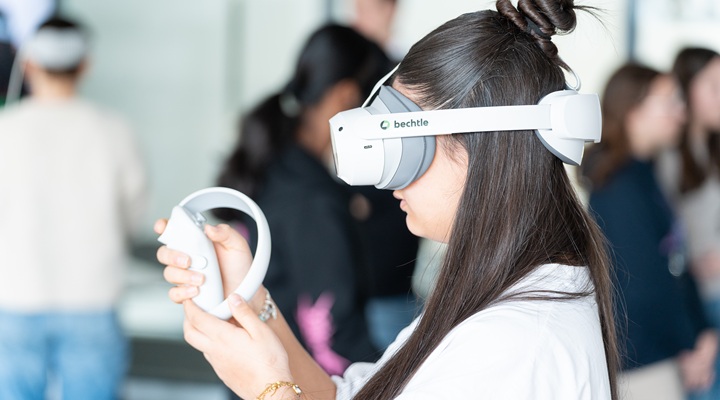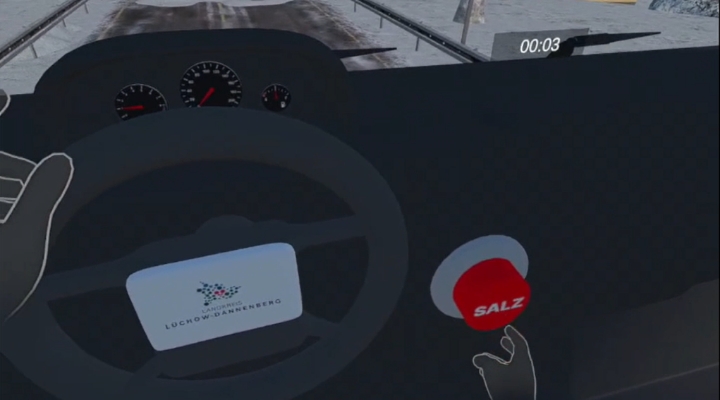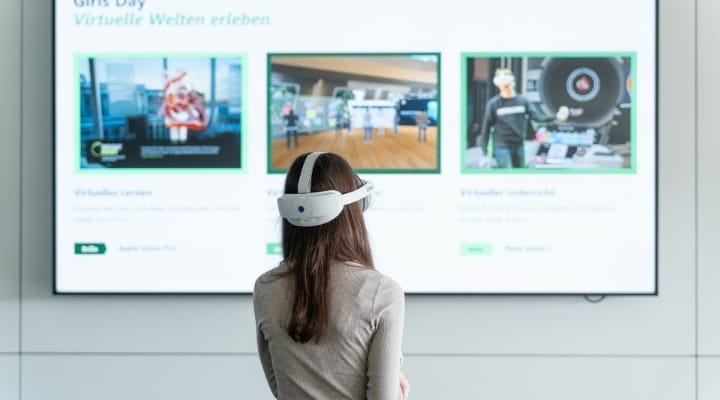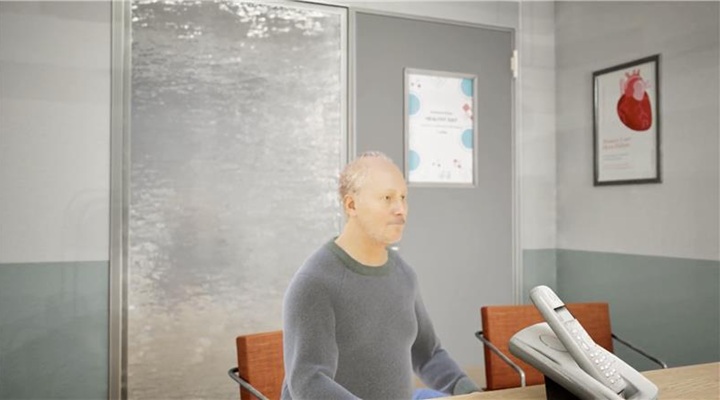Experience virtual worlds together.
Signing up for digital city planning meetings, testing smart lighting solutions yourself in our Virtual Plaza or getting up close with all the chambers and arteries of the heart—virtual worlds let you do all this and more.
What is a virtual world?
A virtual world is a computer-assisted extension of our reality. The degree to which we immerse ourselves depends on the technology we use.
Based on the EU strategies for virtual worlds (persistent, immersive environments based on 3D and extended reality technologies (XR)), we are consciously using the term in a wider sense to include technological aspects like XR as well as terms relating to the Metaverse.
Virtual worlds could be the next big thing to come out of the internet, which in the beginning, was primarily used by experts and scientists before developing into the interactive web we know today. Virtual worlds could transform the internet into a place we can physically experience.

Extended reality (XR) marries augmented reality (AR), mixed reality (MR) and virtual reality (VR) technologies. It allows us to seamlessly connect digital and physical worlds, opening up opportunities previously unimaginable. From impressive 3D visualisation and simplified decision making for town planning to more efficient workflows and new forms of collaboration—XR is a trailblazer for progress. For the public sector in particular, this means simplifying complex processes, creating transparency, and strengthening direct contact with residents and colleagues.

AR overlays digital content such as 3D models, tutorials and real-time data directly onto our actual environment. For example, employees at public utility companies using AR glasses when carrying out maintenance. Experts can remotely give instructions, doing away with long commutes and delays, saving time, money and considerably boosting efficiency and quality.

MR connects physical and digital objects for an interactive experience and its already changing how we learn, work and plan.
City planning – Construction projects can be realistically visualised in the actual environment before any work has even been started.
Medical imaging – Surgeons can practice operations virtually and medical students learn about anatomy on interactive 3D models.
Education – Experiments in physics lessons come to life with MR. Students can learn interactively and better understand how things relate to each other.

VR creates complex digital environments that are immersive and versatile.
Training sessions and courses – Firefighters train for dangerous missions in virtual scenarios—as often as they wish and with no risk.
Virtual tours – Residents can experience historic sites or other hard-to-reach places—such as hidden rooms in protected buildings—bringing history and cultural heritage to life for everyone.

Virtually all major technology companies are investing in XR or are forming alliances, making for a highly dynamic market environment. Which of the technologies will prevail in the long run cannot confidently be predicted. Mixed reality (MR) currently combines the strengths of AR and VR and is developing rapidly. AR devices are also becoming more powerful, easier to use, and more suitable for daily use. Glasses can now be controlled simply by eye movements and gestures and are very comfortable to wear.
Enhancing, not replacing. Added value for the public sector.
Virtual worlds are intended to enhance, not replace reality and personal interactions by making decisions more tangible so that planning can be more precise and collaboration more efficient.

Virtual worlds enable the visualisation and simulation of complex processes and 3D environments for better understanding and ultimately increased acceptance and efficiency.

Leveraging virtual worlds gives the public sector a modern and advanced image, which in turn boosts residents’ trust and employer attractiveness.

Virtual worlds make participation accessible for all public administration employees and residents regardless of their age and physical and cognitive capabilities, and these worlds can be accessed from anywhere.
Want to learn more about our virtual worlds offering?
Want to start leveraging innovative extended reality technologies but not sure how? Let’s work together to find the perfect fit for you.

Holistic solutions from a single source.
Working together, we’ll shape vendor-neutral solutions tailored to your specific public sector use case. Our strong partner network and in-house developments let us provide you with comprehensive support and expertise to successfully shape your virtual worlds.
- Comparison of technical requirements with project aims and specific use cases
- Selection of suitable hardware setups from a range of vendor-neutral options
- Coordination of procurement, configuration, and shipping to all relevant project locations
- Use case specific
- Setup and optimisation of software for each use case
- Guaranteed platform independence and interoperability with existing systems
- Collaboration with partners to provision the required development components such as for specific applications or integrations.
- Definition of use cases based on experiences gathered from pilot and customer projects
- Design and implementation of user experience design including accessibility and user focus
- Organisation and implementation of events like kick-off meetings, stakeholder workshops and user training sessions
- Expert and technical support in project phases
- Communication support
Real use cases. For real problems.
Urban development and smart cities.
Get a real feel for smart cities in our Virtual Plaza.
Interactively experience complex smart city solutions in our digital marketplace, the Virtual Plaza.
Virtual city planning meeting in Aalen.
Meet other residents and the city council in a virtual space to discuss relevant topics and questions. The City of Aalen was the first in Germany to implement this trailblazing technology to discuss construction of a new swimming pool.

I’m really happy with this first experiment […]. In my opinion, the metaverse is a great opportunity to make projects tangible so that we can then present and discuss them with the people.
Frederick Brütting, Mayor of the City of Aalen

Attract talent with experiences.
Traditional formats such as interviews and flyers are no longer sufficient to attract talent for job vacancies or apprenticeships. The district of Lüchow-Dannenberg is therefore promoting itself at training fairs with an interactive XR experience. Interested parties can steer a gritting vehicle through the snow as a road maintenance worker, solve IT problems as an IT specialist, process applications in the role of an administrative assistant or conduct empathetic conversations in social work with realistic AI avatars. The short, gamified scenarios make the tasks tangible and clearly show which skills are required in the profession. Together with MMN, we can also create your specific use cases.
Use case workshops: Hands-on XR.
In joint XR workshops, representatives of the association's municipalities can try out various applications for themselves. From virtual tours and digital citizen dialogues to the reconstruction of historical objects. In short, interactive and sometimes gamified scenarios, specific use cases are played out so that participants can immediately understand the requirements, possibilities and added value. Using the design thinking method, participants develop their own use cases and solutions in which virtual worlds deliver real added value.
Tourism and culture.
Experience a historic city tour.
Bring city history to life wherever you choose. What did the main square look like in the Middle Ages? How did the city gate used to look? As a modern city, Schramberg lets the public “visit” inaccessible places and objects like its historic bell tower.



Education.
Schools – XR applications enrich lessons for students and teachers alike.
- Biology – Experience a realistic representation of the human body and its organs with simulations of heart disease, for example.
- Physics and chemistry – Learn chemical equations and conduct experiments that would otherwise be too dangerous or costly to undertake.
- Languages – Strengthen your language skills in a realistic scenario.
Career path – XR applications provide realistic insights into working days and supports vocational training.
- Care-giver training – Experience and learn the basic principles of caregiving—at your own pace and in line with your current level of expertise.
- IT specialists – Learn how to assemble computer components as well as how they work.
Health.
Medical history trainer.
Learn how to correctly interact with patients with the medical history trainer. In realistic dialogues, you’ll practice the structured acquisition of medial information and strengthen your communication skills, allowing you to prepare for challenging real-life cases while gaining confidence.
Therapy and rehabilitation.
Digital rehabilitation solutions help physiotherapy practices and clinics in the targeted treatment of shoulder and wrist injuries. Conduct tailored exercises with patients whose progress is logged and updated in real time, facilitating flexible, location-independent therapy that promotes sustainable recovery.

*Required field
If you’d like to know more about how we handle your personal data, please read our Privacy Policy.